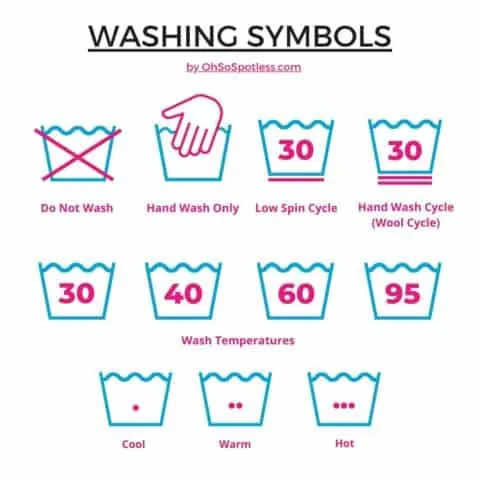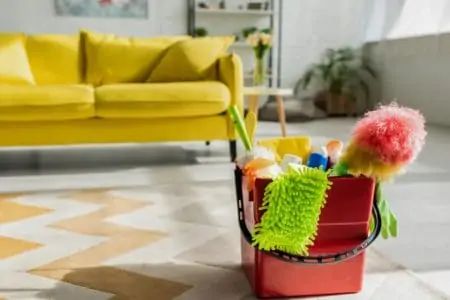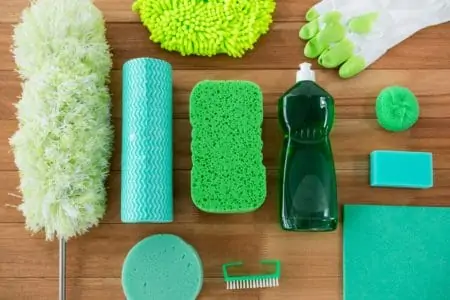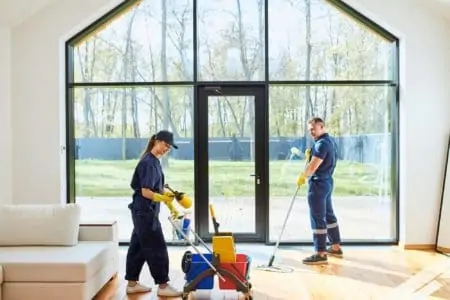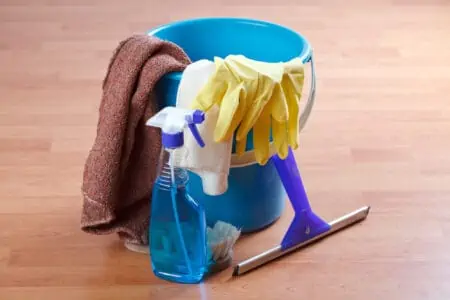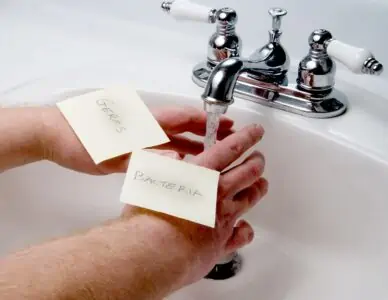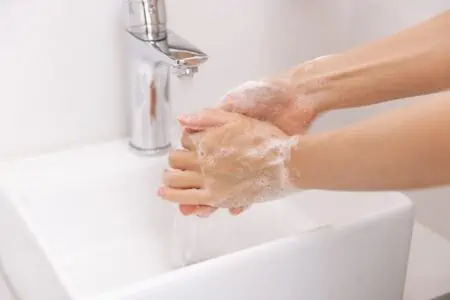Patio cushions are often left to the elements — rain, sleet, snow — and, therefore, get very filthy.
Cleaning cushions can be a confusing task. You might not know where to start, and the care label instructions might be super vague.
That’s where we come in. Our method for how to clean patio cushions will take you through a step-by-step method. It’s easy, doesn’t take too long, and will make your cushions look as good as new.
Key Takeaways
- Patio cushion covers may be machine washable, but check the care label for proper instructions.
- Hand-washing patio cushions can be done using Borax, distilled white vinegar, or a pressure washer for a thorough clean.
- Spot cleaning is useful for removing specific stains and spills without deep cleaning the entire cushion.
- Different types of outdoor cushion fabrics may have unique cleaning requirements, so always check the manufacturer’s instructions.
Are Patio Cushions Machine Washable?
The whole cushion isn’t machine washable, but many cushion covers are. Check the care label for the best instructions. It might state that it’s machine washable, or it might have a symbol.
This symbol looks like a bucket of water. It either has dots to indicate how hot you should wash it, or it has the best temperature to wash the cover.
Don’t machine wash the cushion covers if you have the symbol with an “x” through it or a hand in water.
How to Clean Patio Cushions
While you can clean cushion covers in the washing machine, we have some different methods to share. These instructions are for hand-washing both removable and non-removable patio cushions. Whether you want to use Borax, distilled white vinegar, or a pressure washer, we’ve got you covered.
- Time: 35 minutes, plus drying time.
- Difficulty: Easy/Intermediate.
With Borax
Borax is a great cleaning product for removing mildew and other stains. For this method, keep the cushion cover on the pillow.
- Vacuum: Before getting started, use the upholstery attachment on your vacuum to remove dust and debris on your patio cushion.
- Make a cleaning solution: Mix warm water and ¼ cup of Borax in a bucket. Add one tablespoon of dish soap if you want a stronger cleaning solution. Mix well.
- Scrub: Dip a bristled brush into the cleaning solution and scrub your patio cushion well. Spend extra time on stained areas. Leave the solution on to soak for 15 minutes.
- Rinse: Using your garden hose, rinse the cushions well to remove all Borax and soap residue.
- Dry: Squeeze the cushion well to remove as much excess water as possible. Blot the cushion with a towel to absorb extra moisture. Position the cushions vertically outside in direct sunlight until they’re 100 percent dry.
With Vinegar
Distilled white vinegar is a powerful, non-toxic cleaner. It can also remove mildew, odors, stains, and dirt.
- Vacuum: Start by vacuuming the patio cushions to remove dust and debris.
- Make the solution: In a spray bottle, combine one cup of vinegar with one cup of warm water. Shake to combine.
- Spray the cushion: Spray the entire cushion with the vinegar water solution and let it soak for 15 minutes.
- Scrub: With a bristled cleaning brush, scrub the cushion well, spending extra time on stained areas. You may need to repeat steps three and four until the stains are gone.
- Rinse: Rinse the cushion with a garden hose.
- Dry: Squeeze the cushion to remove excess water. Then blot with a towel to soak up extra moisture. Position the pillows vertically in a sunny spot to air dry 100 percent.
With a Pressure Washer
Many experts don’t recommend using a pressure washer to clean patio cushions because it may damage the fabric. Pressure washing is best for cleaning the porch, car, or house siding.
However, if your cushions don’t have removable covers, this can be an easy way to deep clean them.
Make sure you use a low PSI pressure washer with the highest degree nozzle. We recommend a 40-degree nozzle which is usually white. This is a gentle nozzle with minimal spray, but you should still stand a reasonable distance from the cushions to avoid damage.
- Protect yourself: Before you get started, wear protective clothing. This means a long-sleeved, sturdy rain jacket with a hood, rain pants, and waterproof commercial gloves.
- Position cushions: Put the cushions on a flat surface away from your house. You don’t want the stream of water to accidentally hit your windows or doors and cause damage.
- Add detergent (optional): Some pressure washers take detergent. You might want to add detergent for better results if you have old stains. But it’s not necessary — usually, the pressure washer’s power is enough to deep clean.
- Prepare pressure washer: Ensure your pressure washer is plugged in or full of fuel. Add the correct nozzle. Get children and pets away from the area.
- Get washing: Standing above the pillows, but holding the pressure washer hose as far away as possible, start pressure washing. Start at the top of the cushion and work your way down slowly, then move from side to side. Repeat on every cushion.
- Stains: Spend extra time on stains but don’t hold the pressure washer in one spot for too long. This might damage the fabric, causing tears and holes.
- Rinse well: If you used detergent, rinse the cushions well with your garden hose to remove soap residue.
- Dry: Squeeze the cushions to remove excess moisture. Blot with a towel. Position vertically in a sunny spot until they’re 100 percent dry.
Pressure Washing Tip
When pressure washing patio cushions, we recommend doing this once a year. If you do it too often, your cushions will quickly wear down. You want your cushion to last a while — so save this for when it’s really necessary.
How to Spot Clean Patio Cushions
Cleaning patio cushions is pretty easy, but it still takes around 35 minutes. When you notice a stain, spill, or dirt, you might not have time to deep clean the whole cushion. That’s where spot cleaning comes in.
- Time: 45 minutes.
- Difficulty: Easy.
What You’ll Need
- Water.
- Spray bottle.
- Dish soap.
- Soft-bristled brush.
- Garden hose.
1. Prepare the Solution
In a spray bottle, mix lukewarm water with one tablespoon of dish soap. Shake well.
Top Tip
Keep this ready-made in your kitchen cupboard. It’ll come in handy for basically any stain!
2. Spray the Stain
With your soapy solution, spray the stained area. The quicker you treat the stain, the better your chance of removing it completely.
3. Let It Soak
Leave the soapy solution on the stain for 30 minutes. One hour is best for greasy stains.
4. Scrub the Stain
Using a soft-bristled brush, scrub the stained area, working the soap into the stain. Scrub for about one minute. You can repeat this later if the stain isn’t gone.
5. Rinse the Cushion
Use your garden hose to rinse the stained area. Keep going until the stain is mostly gone.
If the stain persists, you can repeat steps two to five.
6. Dry the Cushion
Squeeze the cushion to remove excess water before blotting with a towel. Position the cushion vertically in a sunny spot to finish air drying.
Cleaning Different Types of Outdoor Cushions
Patio cushions come in a range of fabrics which often have different cleaning requirements. Let’s walk through some of the most common fabrics and their accompanying cleaning instructions:
- Delicate fabric: If your cushion is made from a delicate fabric (like wool) or has embellishments, hand-wash it only. Don’t use a garden hose, and certainly never use a pressure washer.
- Memory foam cushions: Don’t get foam cushions wet. They cling to more liquid, which means they take longer to dry. When they’re done drying, mold and mildew might have already taken hold.
- Woven acrylics: These are one of the most common kinds of outdoor cushions. You can use our tips mentioned already for cleaning. This material is very resistant to stains, moisture, and fading, making it hard to damage.
- Synthetic fabrics: Synthetic fabrics like olefin and polyester are also very durable. You can use any of our tips so far. In fact, if you have olefin, it will be the most resistant to pressure washing, so you can test the power wash method.
- Waterproof fabrics: Most outdoor cushions are treated with a waterproof finish. You can use our tips above to clean these cushions.
- Sunbrella: Sunbrella is a popular outdoor cushion brand. To clean their cushions, you can use our spot-cleaning tips with water and dish soap. Rinse with a garden hose, but never use a pressure washer.
How to Get Stains Out of Patio Cushions
When learning how to wash outdoor cushions, it’s important to arm yourself with knowledge for every kind of stain. The sooner you tackle a stain, the better your chance of permanently removing it. We’ll walk through different types of stains, sharing our best methods for cleaning them.
- Mildew: Borax or white vinegar will do a great job.
- Bird poop: Start by scraping off as much bird poop as you can. Spray the cushions with a mix of warm water and laundry detergent. Then, scrub the area with a soft brush until the bird poop has lifted.
- Grass: Apply laundry detergent to the stain with a soft-bristled brush. Scrub from side to side in the direction of the fabric. Rinse with warm water.
If the stain persists, mix water with OxiClean at a 3:1 ratio. Apply it to the stain, soak for one hour, then rinse well. - Mold: The Borax method is best for mold-stained cushions. But some fabrics do allow you to clean with bleach, which will be highly effective. Mix one tablespoon of bleach per pint of water and scrub it onto the pillow, leaving it for 30 minutes before rising.
- Food and grease stains: Sprinkle baking soda over the stain to absorb excess oil. Scrape it off before following our How to Spot Clean Patio Cushions instructions.
- Blood: Mix ½ tablespoon of dish soap and ¼ cup of hydrogen peroxide with one cup of cool water. Apply it to the stain for 10 minutes before blotting with a damp cloth. Repeat if necessary.
- Tree sap: This sticky stain can be hard to remove, but not with an enzyme-based stain remover. Something like Rocco & Roxie applied directly to the stain for 15 minutes can be excellent at tackling tree-sap. While it’s soaking, make a paste with baking soda and water — apply it to the stain and scrub with a bristled brush before rinsing.
- Wine: If it’s red wine, dilute it with water. Blot with paper towels. Sprinkle baking soda over the stain for a few minutes before shaking it off.
Then mix ¼ cup of dish soap with ¼ cup of hydrogen peroxide. Apply it to the stain for 30 minutes. Rinse with warm water.
Warning About Bleach
Before using bleach on your outdoor cushions, be sure to check the manufacturer’s label first. Bleach isn’t suitable for every material. Keep in mind that bleach will whiten colors, so this is best for white cushions.
Tips For Keeping Your Cushions Clean
You know how to clean outdoor cushions, but what if you didn’t have to? What if you maintained them to perfection, so cleaning was a rare chore? Here are our top tips for taking care of your patio cushions.
- Dry brush often: To prevent dust and debris from causing stains, dry brush your cushions often. You can vacuum instead if that’s more convenient.
- Deal with stains ASAP: When you notice a stain or a spill, don’t dilly-dally. Stop mid-conversation to tackle that before it sets in.
- Cover your cushions: When you’re not using them, or rain is in the forecast, cover your cushions. You may even want to store them inside. Make sure to clean them before storing them so you can tackle any stains before they are permanently set.
- Use fabric protectant: A fabric protectant, like Bayes Fabric Protectant, can create a waterproof, stain-resistant, UV-resistant coating on your outdoor cushions. This means they won’t harbor as many stains. Plus, they’ll be easier to clean.
- Use an awning: To prevent bird droppings and tree sap, consider installing an awning over your outdoor furniture. This will also keep your cushions away from UV rays which can cause fading.

